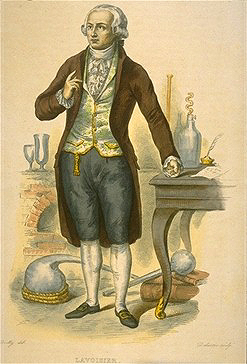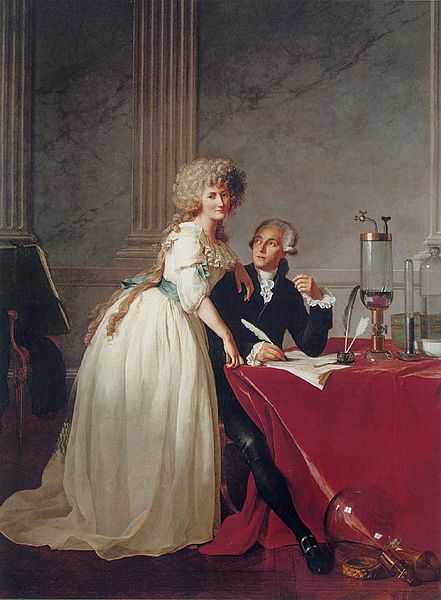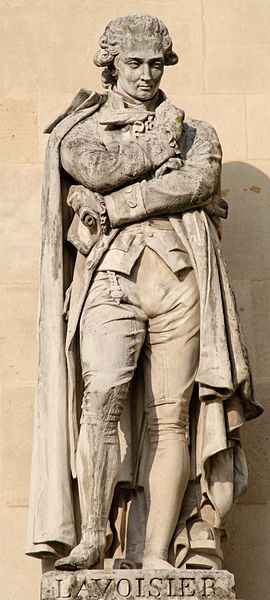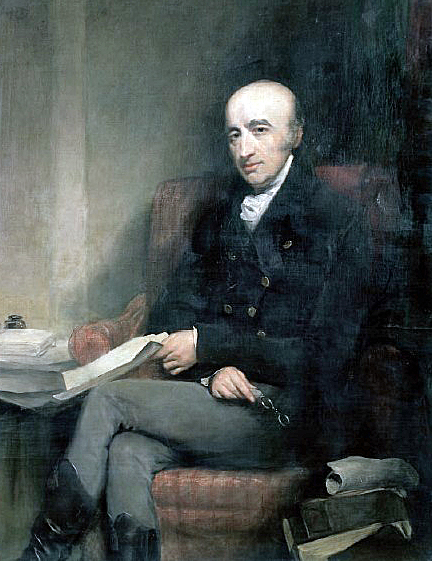<Back to Index>
- Biologist and Chemist Antoine - Laurent de Lavoisier, 1743
- Chemist and Physicist William Hyde Wollaston, 1766
PAGE SPONSOR




Antoine - Laurent de Lavoisier (also Antoine Lavoisier after the French Revolution; 26 August 1743 – 8 May 1794), the "father of modern chemistry," was a French nobleman prominent in the histories of chemistry and biology. He named both oxygen (1778) and hydrogen (1783) and helped construct the metric system, put together the first extensive list of elements, and helped to reform chemical nomenclature. He was also the first to establish that sulfur was an element (1777) rather than a compound. He discovered that, although matter may change its form or shape, its mass always remains the same.
He was an administrator of the Ferme Générale and a powerful member of a number of other aristocratic councils. All of these political and economic activities enabled him to fund his scientific research. At the height of the French Revolution, he was accused by Jean - Paul Marat of selling adulterated tobacco, and of other crimes and was eventually guillotined a year after Marat's death. Benjamin Franklin was familiar with Antoine, as they were both members of the "Benjamin Franklin inquiries" into Mesmer and animal magnetism.
Born to a wealthy family in Paris, Antoine - Laurent Lavoisier inherited a large fortune at the age of five with the passing of his mother. He was educated at the Collège des Quatre - Nations (also known as Collège Mazarin) from 1754 to 1761, studying chemistry, botany, astronomy and mathematics. He was expected to follow in his father's footsteps and even obtained his license to practice law in 1764 before turning to a life of science. His education was filled with the ideals of the French Enlightenment of the time, and he was fascinated by Pierre Macquer's dictionary of chemistry. He attended lectures in the natural sciences. Lavoisier's devotion and passion for chemistry were largely influenced by Étienne Condillac, a prominent French scholar of the 18th century. His first chemical publication appeared in 1764. From 1763 to 1767, he studied geology under Jean - Étienne Guettard. In collaboration with Guettard, Lavoisier worked on a geological survey of Alsace - Lorraine in June 1767. At the age of 25, he was elected a member of the French Academy of Sciences, France's most elite scientific society, for an essay on street lighting and in recognition of his earlier research. In 1769, he worked on the first geological map of France.
In 1771, at the age of 28, Lavoisier married 13 year old Marie - Anne Pierrette Paulze, the daughter of a co-owner of the Ferme générale. Over time, she proved to be a scientific colleague to her husband. She translated English documents for him, including Richard Kirwan's Essay on Phlogiston and Joseph Priestley's research. She created many sketches and carved engravings of the laboratory instruments used by Lavoisier and his colleagues. She edited and published Lavoisier’s memoirs (whether any English translations of those memoirs have survived is unknown as of today) and hosted parties at which eminent scientists discussed ideas and problems related to chemistry.
Lavoisier demonstrated the role of oxygen in the rusting of metal, as well as oxygen's role in animal and plant respiration. Working with Pierre - Simon Laplace, Lavoisier conducted experiments that showed that respiration was essentially a slow combustion of organic material using inhaled oxygen. Lavoisier's explanation of combustion disproved the phlogiston theory, which postulated that materials released a substance called phlogiston when they burned.
Lavoisier discovered that Henry Cavendish's "inflammable air," which Lavoisier had termed hydrogen (Greek for "water former"), combined with oxygen to produce a dew which, as Joseph Priestley had reported, appeared to be water. In "Mémoire sur la combustion en général" ("On Combustion in General," 1777) and "Considérations générales sur la nature des acides" ("General Considerations on the Nature of Acids," 1778), he demonstrated that the "air" responsible for combustion was also the source of acidity. In 1779, he named this part of the air "oxygen" (Greek for "becoming sharp" because he claimed that the sharp taste of acids came from oxygen), and the other "azote" (Greek "no life"). In "Réflexions sur le phlogistique" ("Reflections on Phlogiston," 1783), Lavoisier showed the phlogiston theory to be inconsistent. But Priestley refused to believe Lavoisier's results before his death.
Lavoisier's researches included some of the first truly quantitative chemical experiments. He carefully weighed the reactants and products in a chemical reaction, which was a crucial step in the advancement of chemistry. He showed that, although matter can change its state in a chemical reaction, the total mass of matter is the same at the end as at the beginning of every chemical change. Thus, for instance, if a piece of wood is burned to ashes, the total mass remains unchanged. Lavoisier's experiments supported the law of conservation of mass, which he was the first to state, although Mikhail Lomonosov (1711 – 1765) had previously expressed similar ideas in 1748 and proved them in experiments. Others who anticipated the work of Lavoisier include Jean Rey (1583 – 1645), Joseph Black (1728 – 1799), and Henry Cavendish (1731 – 1810).
Lavoisier investigated the composition of water and air, which at the time were considered elements. He determined that the components of water were oxygen and hydrogen, and that air was a mixture of gases, primarily nitrogen and oxygen. With the French chemists Claude - Louis Berthollet, Antoine Fourcroy and Guyton de Morveau, Lavoisier devised a systematic chemical nomenclature. He described it in Méthode de nomenclature chimique (Method of Chemical Nomenclature, 1787). This system facilitated communication of discoveries between chemists of different backgrounds and is still largely in use today, including names such as sulfuric acid, sulfates, and sulfites.
Lavoisier's Traité élémentaire de chimie (Elementary Treatise on Chemistry, 1789, translated into English by Scotsman Robert Kerr) is considered to be the first modern chemistry textbook. It presented a unified view of new theories of chemistry, contained a clear statement of the law of [conservation of mass], and denied the existence of phlogiston. This text clarified the concept of an element as a substance that could not be broken down by any known method of chemical analysis, and presented Lavoisier's theory of the formation of chemical compounds from elements.
While many leading chemists of the time refused to accept Lavoisier's new ideas, demand for Traité élémentaire as a textbook in Edinburgh was sufficient to merit translation into English within about a year of its French publication. In any event, the Traité élémentaire was sufficiently sound to convince the next generation.
Lavoisier's fundamental contributions to chemistry were a result of a conscious effort to fit all experiments into the framework of a single theory. He established the consistent use of the chemical balance, used oxygen to overthrow the phlogiston theory, and developed a new system of chemical nomenclature which held that oxygen was an essential constituent of all acids (which later turned out to be erroneous). Lavoisier also did early research in physical chemistry and thermodynamics in joint experiments with Laplace. They used a calorimeter to estimate the heat evolved per unit of carbon dioxide produced, eventually finding the same ratio for a flame and animals, indicating that animals produced energy by a type of combustion reaction.
Lavoisier also contributed to early ideas on composition and chemical changes by stating the radical theory, believing that radicals, which function as a single group in a chemical process, combine with oxygen in reactions. He also introduced the possibility of allotropy in chemical elements when he discovered that diamond is a crystalline form of carbon.
However, much to his professional detriment, Lavoisier discovered no new substances, devised no really novel apparatus, and worked out no improved methods of preparation. He was essentially a theorist, and his great merit lay in the capacity of taking over experimental work that others had carried out — without always adequately recognizing their claims — and by a rigorous logical procedure, reinforced by his own quantitative experiments, of expounding the true explanation of the results. He completed the work of Black, Priestley and Cavendish, and gave a correct explanation of their experiments.
Overall, his contributions are considered the most important in advancing chemistry to the level reached in physics and mathematics during the 18th century.
Lavoisier used a calorimeter to measure heat production as a result of respiration in a guinea pig. The outer shell of the calorimeter was packed with snow, which melted to maintain a constant temperature of 0 °C around an inner shell filled with ice. The guinea pig in the center of the chamber produced heat which melted the ice. The water that flowed out of the calorimeter was collected and weighed. Lavoisier used this measurement to estimate the heat produced by the guinea pig's metabolism. Lavoisier concluded, "la respiration est donc une combustion," that is, respiratory gas exchange is a combustion, like that of a candle burning.
Lavoisier received a law degree and was admitted to the bar, but never practiced as a lawyer. He did become interested in French politics, and at the age of 26 he obtained a position as a tax collector in the Ferme Générale, a tax farming company, where he attempted to introduce reforms in the French monetary and taxation system to help the peasants. While in government work, he helped develop the metric system to secure uniformity of weights and measures throughout France.
Lavoisier was a powerful figure in the deeply unpopular Ferme Générale, 28 feudal tax collectors who were known to profit immensely by exploiting their position. He was branded a traitor by the Assembly under Robespierre, during the Reign of Terror, in 1794. He had also intervened on behalf of a number of foreign born scientists including mathematician Joseph Louis Lagrange, granting them exception to a mandate stripping all foreigners of possessions and freedom. Lavoisier was tried, convicted, and guillotined on 8 May in Paris, at the age of 50.
Lavoisier was actually one of the few liberals in his position, although all tax collectors were executed during the Revolution. According to a (probably apocryphal) story, the appeal to spare his life so that he could continue his experiments was cut short by the judge: "La République n'a pas besoin de savants ni de chimistes ; le cours de la justice ne peut être suspendu." ("The Republic needs neither scientists nor chemists; the course of justice cannot be delayed.")
Lavoisier's importance to science was expressed by Lagrange who lamented the beheading by saying: "Cela leur a pris seulement un instant pour lui couper la tête, mais la France pourrait ne pas en produire une autre pareille en un siècle." ("It took them only an instant to cut off his head, but France may not produce another such head in a century.")
One and a half years following his death, Lavoisier was exonerated by the French government. When his private belongings were delivered to his widow, a brief note was included, reading "To the widow of Lavoisier, who was falsely convicted."
About a century after his death, a statue of Lavoisier was erected in
Paris. It was later discovered that the sculptor had not actually
copied Lavoisier's head for the statue, but used a spare head of the Marquis de Condorcet,
the Secretary of the Academy of Sciences during Lavoisier's last years.
Lack of money prevented alterations from being made. The statue was
melted down during the Second World War and has not since been replaced.
However, one of the main "lycées" (high schools) in Paris and a street in the 8th arrondissement are named after Lavoisier, and statues of him are found on the Hôtel de Ville and on the façade of the Cour Napoléon of the Louvre.
Lavoisier is listed among eminent Roman Catholic scientists, and as such he defended his faith against those who attempted to use science to attack it. Louis Edouard Grimaux, author of the standard French biography of Lavoisier, and the first biographer to obtain access to Lavoisier’s papers, writes the following:
Raised in a pious family which had given many priests to the Church, he had held to his beliefs. To Edward King, an English author who had sent him a controversial work, he wrote, “You have done a noble thing in upholding revelation and the authenticity of the Holy Scripture, and it is remarkable that you are using for the defense precisely the same weapons which were once used for the attack.”

William Hyde Wollaston FRS (6 August 1766 – 22 December 1828) was an English chemist and physicist who is famous for discovering two chemical elements and for developing a way to process platinum ore.
Wollaston was born in East Dereham, Norfolk, the son of the priest - astronomer Francis Wollaston (1737 – 1815) and his wife Althea Hyde. He was educated at Gonville and Caius College, Cambridge: in 1793 William obtained a doctorate in medicine from Cambridge University and was a fellow of his college from 1787 to 1828. During his studies he became interested in chemistry, crystallography, metallurgy and physics. The mineral wollastonite is named after him. In 1800 he left medicine and concentrated on pursuing these interests instead of his trained vocation. He was elected a Fellow of the Royal Society in 1793.
Wollaston died in London in 1828 and was buried in Chislehurst, England.
Wollaston became wealthy by developing the first physico - chemical method for processing platinum ore in practical quantities, and in the process of testing the device he discovered the elements palladium (symbol Pd) in 1803 and rhodium (symbol Rh) in 1803.
Anders Gustav Ekeberg discovered tantalum in 1802, however, William Hyde Wollaston declared it was identical with niobium (then known as columbium). Due to Wollaston's influence the existence of columbium was temporarily denied. Later Heinrich Rose proved in 1846 that columbium and tantalum were indeed different elements and he renamed columbium "niobium".
Wollaston also performed important work in electricity. In 1801, he performed an experiment showing that the electricity from friction was identical to that produced by voltaic piles. During the last years of his life he performed electrical experiments that would pave the way to the eventual design of the electric motor. Controversy erupted when Michael Faraday constructed the first working electric motor and hastily published his results without acknowledging Wollaston's previous work. Wollaston, however, saw nothing wrong with Faraday's action. Wollaston also invented a battery that allowed the zinc plates in the battery to be raised out of the acid, so that the zinc wouldn't be dissolved as quickly as it would if it were in the battery all the time.
His optical work was important as well, where he is remembered for his observations of dark Fraunhofer lines in the solar spectrum (1802), which eventually led to the discovery of the elements in the Sun. He invented the camera lucida (1807), the reflecting goniometer (1809), and the Wollaston prism. He also developed the first lens specifically for camera lens called Wollaston's meniscus lens, or just meniscus lens, in 1812. The lens was designed to improve the image projected by the camera obscura. By changing the shape of the lens, Wollaston was able to project a flatter image, eliminating much of the distortion that was a problem with many of that day's biconvex lenses.
Wollaston used his Bakerian lecture in 1805, On the Force of Percussion, to defend Gottfried Leibniz's principle of vis viva, an early formulation of the conservation of energy. Wollaston was too ill to deliver his final Bakerian in 1828 and dictated it to Henry Warburton who read it on 20 November.
Wollaston's attempt to demonstrate the presence of glucose in the blood serum of diabetics was unsuccessful due to the limited means of detection available to him. His 1811 paper "On the non - existence of sugar in the blood of persons labouring under diabetes mellitus" concluded that sugar must travel via lymphatic channels from the stomach directly to the kidneys, without entering the bloodstream. Wollaston supported this theory by referring to the thesis of a young medical student at Edinburgh, Charles Darwin (1758 - 1778), "Experiments establishing a criterion between mucaginous and purulent matter. And an account of the retrograde motions of the absorbent vessels of animal bodies in some diseases." This Charles Darwin was the eldest son of Erasmus Darwin and not his more famous nephew, Charles Robert Darwin.
Wollaston also served on a royal commission that opposed adoption of the metric system (1819), and one that created the imperial gallon.